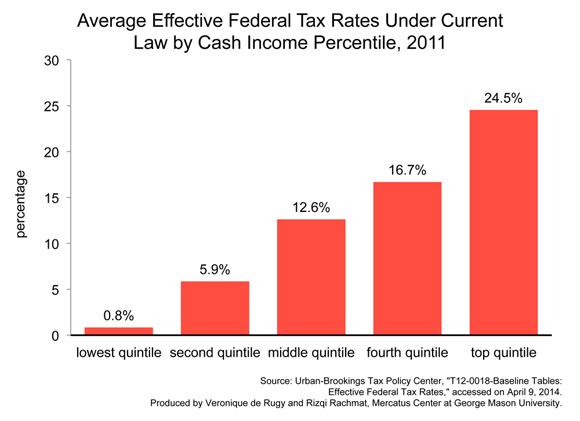- | Government Spending Government Spending
- | Data Visualizations Data Visualizations
- |
Updated: Average Effective Federal Tax Rates
This week’s chart uses data from the Urban-Brookings Tax Policy Center to update a chart on average effective federal rates. The chart compares the average effective rate at which earners in different income quintiles are taxed by the federal government using newly available numbers for 2011.
This week’s chart uses data from the Urban-Brookings Tax Policy Center to update a chart on average effective federal rates. The chart compares the average effective rate at which earners in different income quintiles are taxed by the federal government using newly available numbers for 2011.
These averages, however, fail to disclose the true scope of the problem caused by the increasingly convoluted tax code since the income tax was instituted in 1913. One of the more troubling features of our present tax system is that two individuals who earn the same level of income and who fall in the same income tax bracket may end up paying significantly different taxes on their incomes on tax day. This is, as economist Jeremy Horpedahl points out in his Mercatus Research paper, “A Trillion Little Subsidies,” the consequence of the US’s complicated tax code, which contains a host of deductions, credits, and offsets that apply to some individuals and not others.
An accurate picture of the true average tax rate facing different income quintiles, must include consideration of the impact of these disparate tax subsidies. The effective federal income tax rate does this by documenting the level of taxation that individuals pay after all other tax offsets and deductions are applied.
The chart shows a pattern of steadily increasing average effective tax rates moving from the lowest to the highest income quintiles. In 2011, the lowest income quintile faced an average effective tax rate of 0.8 percent, while the top quintile faced an average effective tax rate of 24.5 percent. The average effective federal tax rate faced by different income quintiles are inarguably progressive, once tax offsets are factored in. On average, wealthy Americans pay more in taxes than members of any other income group, even when deductions and write-offs are taken into account. Across the board, the rate of taxation increases with the level of earnings.
Whether one thinks that the current system is fair, unfair, or just right, there can be little debate that federal income taxes are indeed progressive.


